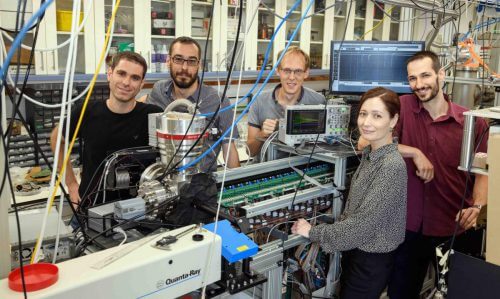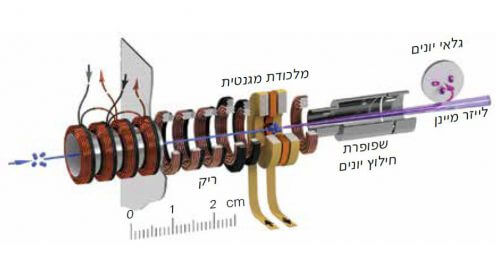Weizmann Institute scientists cooled molecules to a fraction of a degree above absolute zero by trapping them in magnetic traps made of superconducting wires and evaporating the hot molecules from the trap

In the hot days of the summer of 2019, it seems only natural that scientists would try to find original and creative ways of cooling. This is exactly what Prof. Ed Narevicius and the members of his research group in the Department of Chemical and Biological Physics at the Weizmann Institute of Science did - except that their research has nothing to do with the Earth's climate or weather forecasts. In fact, they focused on tiny molecular systems inside sophisticated "traps" in their well-ventilated laser labs.
The overarching goal of this research stems from the fact that heat is, in fact, a constant vibration of the atoms or molecules. That is, if you want to carefully examine the properties of molecules and atoms, you have to slow down their oscillation, which means cooling. One way to slow down (and cool) atoms is based on sending laser beams at the atoms, from all directions, which significantly slows their oscillation and cools them. But this efficient method is not possible to apply in molecules, for various reasons.

Prof. Narevičius and his group members decided to face the challenge of cooling molecules in a different way - through a process of evaporation (that is, in a way similar to the one in which we feel cooling when disinfecting with alcohol or using aftershave products, or similar to how our coffee or soup cools ). But in order to cool a "soup of molecules" by evaporation, they must be captured in a "bowl" - a rather challenging process. The institute's scientists faced this challenge using a very complex technological system that they developed and built especially for this purpose.
In the first step, the scientists used a container with a mixture of oxygen and krypton gases at room temperature. The gas, in the way of nature, spreads into a void (vacuum) in a way that may appear as a kind of beam of particles that scatter into the empty space. In this way, the temperature of the gas drops to the level of one degree Kelvin (that is, one degree above absolute zero). At this stage, the molecules in the system "fly" at a speed of about 400 meters per second - a tremendous speed, which does not allow them to be trapped in a vacuum. In order to slow down the molecules, Prof. Narevičius and his group members built a magnetic trap - a kind of "box" or "cup" - made of strong magnetic fields, which are created using superconductor wires. This method makes it possible to increase the strength of the magnetic fields very quickly, which confines the molecules in a limited volume and increases the rate of their collision with each other. In this situation, it is possible to evaporate the hot molecules from the trap - and cool those remaining in it to only a fraction of one degree above absolute zero.
More of the topic in Hayadan:

9 תגובות
Conan you are wrong on many points:
1. Temperature is kinetic energy of molecules, or atoms in the case of an element. At absolute zero - the atom does not move. The electron is not a moving body around the nucleus - it is everywhere in the orbital (and you can also say everywhere in the universe..)
2. Spin is not related to temperature. What is meant by absolute zero is not zero energy.
3. What exactly are interactions between the particles?
4. Of course it is necessary to prevent the impact of other particles. I guess it's part of the experiment.
The rest of your points are the same - not related to temperature.
And just so you know - the temperature has already been lowered *below* absolute zero!
https://www.livescience.com/25959-atoms-colder-than-absolute-zero.html
Even the simplest system: a hydrogen atom (containing a single proton and a single electron moving around it) cannot be cooled to "absolute zero" because:
1. The electron will always be able to drop to at least a minimum energy level (ie movement in the 1S atomic orbital), which means that the electron in the atom will never stop, and will always have kinetic energy.
2. In addition to the kinetic energy of the electron, there is also a spin for all the electrons and all the nucleons in the nucleus, which also cannot be eliminated; Indeed, in the past they have shown that it is possible to cool pure solids and reduce the value of the spin energy - known as "spin coupling" and "spin-rail coupling" by applying extremely strong magnetic fields, which arrange all the particles with spin in one direction (using NMR with a powerful magnet ) - but even here it is not possible to cancel the spin contribution completely.
3. Even in the simplest system (= a hydrogen atom), and of course also in larger systems - that is, heavier atoms and diatomic and polyatomic molecules - there will always be additional interactions between all the particles (within the nucleus of the large atoms there will be interactions due to the action of the weak force and the strong the force between the nucleons and within each nucleon, respectively).
4. Of course, it is also necessary to completely prevent the impact of neutrino particles and other cosmic radiation from around the universe, in addition to preventing any movement of phonons in the material - actions that cannot be prevented, even if you work in garaged laboratories located in caves in the depths of the earth) - not to mention the electromagnetic forces and the gravitational ones that are constantly acting between all the particles and themselves.
5. According to quantum mechanics, even in a high vacuum, there will be fluctuations of elementary particles; Thus, for example, it is possible for an electron/positron pair to form anywhere in the universe, which if they ionize each other in a period of time shorter than the "Planck time" - this pair of particles will never be able to be detected, but it will certainly have an effect on the temperature at the point where the pair is formed.
6. Always remember the existence of the cosmic background radiation (2-4 degrees Kelvin) that exists all over the universe - also inside the experimental systems in all the laboratories that have been built, are being built and will be built.
7. What about disturbances of the dark matter (Dark Matter) which do not appear in any calculation presented in this study?
In conclusion, due to all these and other disturbances - which cannot be completely avoided - and assuming that the physics I based myself on here is correct (and not like Newton's physics which was disproved by Einstein) - it will never be possible to cool down and reach absolute zero!!!
The temperature in the universe is on average 2.73, it is not some theoretical barrier nor an actual barrier. There are simply a lot of photons at that wavelength. The fact that the temperature in the trap will rise at the end is also irrelevant, (the refrigerator at home also holds material at a lower temperature than the environment.)
Yehuda
Space is not completely empty. In absolute vacuum the temperature is absolute 0.
When the temperature in the entire universe is at least 2.73 degrees Kelvin, it's hard for me to understand how they got down from this temperature. With all the neutrinos, photons and other cosmic rays moving in the universe, it is only a matter of a very short time for the molecule to start moving again, that is, the temperature will return to at least 2.73 degrees Kelvin.
Good night
Sabdarmish Yehuda
Idan you are a jerk.
The fact that you have a bulbul does not mean that you are on the same level as other bulbuls and certainly does not make you better than those without bulbuls. Your retarded response only proves who you are.
Very similar to all the idiots who happened to be born in the Jewish state and are proud of the number of Jewish/Israeli Nobel Prizes even though they barely finished high school.
They are not you! On the contrary! They succeed in spite of you.
And let's just say... let's just say that they manage to overcome this unruly fraction and cool the molecule down to absolute zero...
Will this really be the difference between a "living" atom and an atom in which the electron stops rotating around the nucleus and the atom, followed by the entire molecule, will collapse in on itself and the object will form a tiny black hole that will grow as it swallows the scientists, the laboratory, the institute, followed by the city, etc...?
I do not think so…
If the fraction of a degree was let's say a thousandth of a degree, they could already follow the electron in slow motion...
"A fraction of one degree" - does it occur to you to write what that "fraction" is? tenth? hundredth? Ten minus ten?
How funny - you see who controls science
There are 4 men and one woman who wants to "prove" that she is a man.